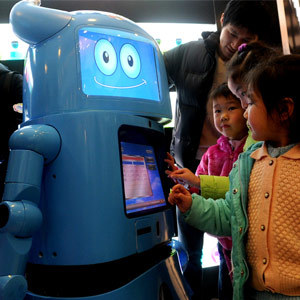viernes, 27 de septiembre de 2013
domingo, 1 de septiembre de 2013
Planning a Robot: The Vaccinator 3000
This week's task is to plan a robot, that would help to solve a problem. My group is also formed by Mr. Reynolds and Mr. Oporto.
 Here are some questions that will help to guide our planning:
Here are some questions that will help to guide our planning:What problem or challenge does the robot solve?
The robot tries to solve the main problem which is observed in hospitals: many doctors and nurses are taking care of people that don't require their help so much. So this robot would help to relief some of the work of the nurses and doctors, as it would vaccinate in winter (when the rooms are full of people with a cold or something worse), and also it would derive patients from emergency room, so that they receive specialized attention according to what they need (and without using time of other doctors).
What are some of the functions you will program your robot to carry out?
There are mainly two programs: the first, used in winters, when many people has the flu, and this robot would vaccinate them faster than a human being.
The second program of the robot, is to derive people, and for that, it would have a huge database of every symptoms and their respective possible illnesses.
What materials will it be made out of? Why?
It will be made of metal and the corresponding circuits to assure its functioning, because it's the easiest way to create and program a robot.
How will the robot sense its surroundings?
It will have thermal sensors, to perceive if it's in front of a person or of an object. It will also be able to communicate, and "understand" (through a variety of computational programs).
It will have thermal sensors, to perceive if it's in front of a person or of an object. It will also be able to communicate, and "understand" (through a variety of computational programs).
How will it move and respond to the environment?
It will have wheels, to guarantee an easy movement through the room, where it will go from bed to bed, and from patient to patient, also helped by its thermal sensors.
It will have wheels, to guarantee an easy movement through the room, where it will go from bed to bed, and from patient to patient, also helped by its thermal sensors.
How or why is a robot better equipped to handle this challenge than a human?
A robot would be faster than a human, and also it would make doctors only occupate on other issues in which they might be more required.
What specific functions will the robot carry out? What components will the robot include that help it carry out these tasks?
The robot will have the two programs mentioned above, one of them would help him to complete the task of vaccinating people, and the other one, to "understand" and link symptoms to their respective illness, and then derive the patient to a specialized doctor.
What will the robot look like? Will it look human-like? Why or why not?
It will be the cheapest possible. Probably a "box" (cube) with an arm.
A robot would be faster than a human, and also it would make doctors only occupate on other issues in which they might be more required.
What specific functions will the robot carry out? What components will the robot include that help it carry out these tasks?
The robot will have the two programs mentioned above, one of them would help him to complete the task of vaccinating people, and the other one, to "understand" and link symptoms to their respective illness, and then derive the patient to a specialized doctor.
What will the robot look like? Will it look human-like? Why or why not?
It will be the cheapest possible. Probably a "box" (cube) with an arm.
How will the robot’s appearance influence how people interact with it?
At first people may be scared, but then they'll get used to it and it will be the same as being vaccinated by a person or a human-like robot.
What limitations does the robot have?One of the most important limitations of the robot, is its inability to understand emotions, and as it derives patients in urgency room, it might be wrong in some cases, as emotiveness can affect the patients' trustability and even his/her sickness.
Another problem it could have, is to fail in its mechanical structure.
Suscribirse a:
Entradas (Atom)
